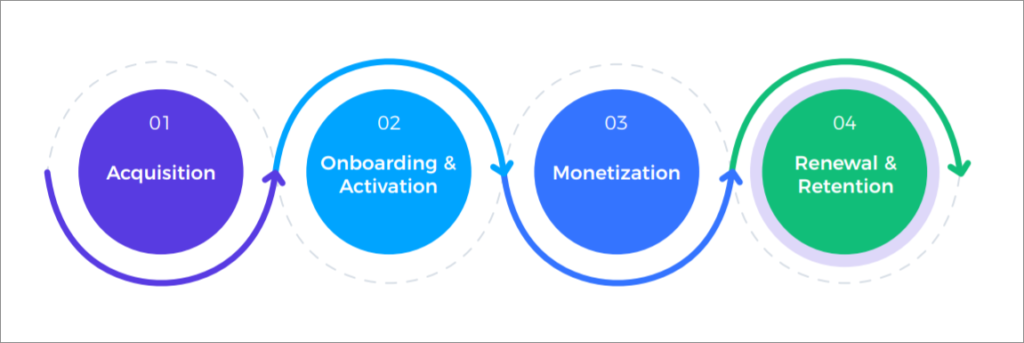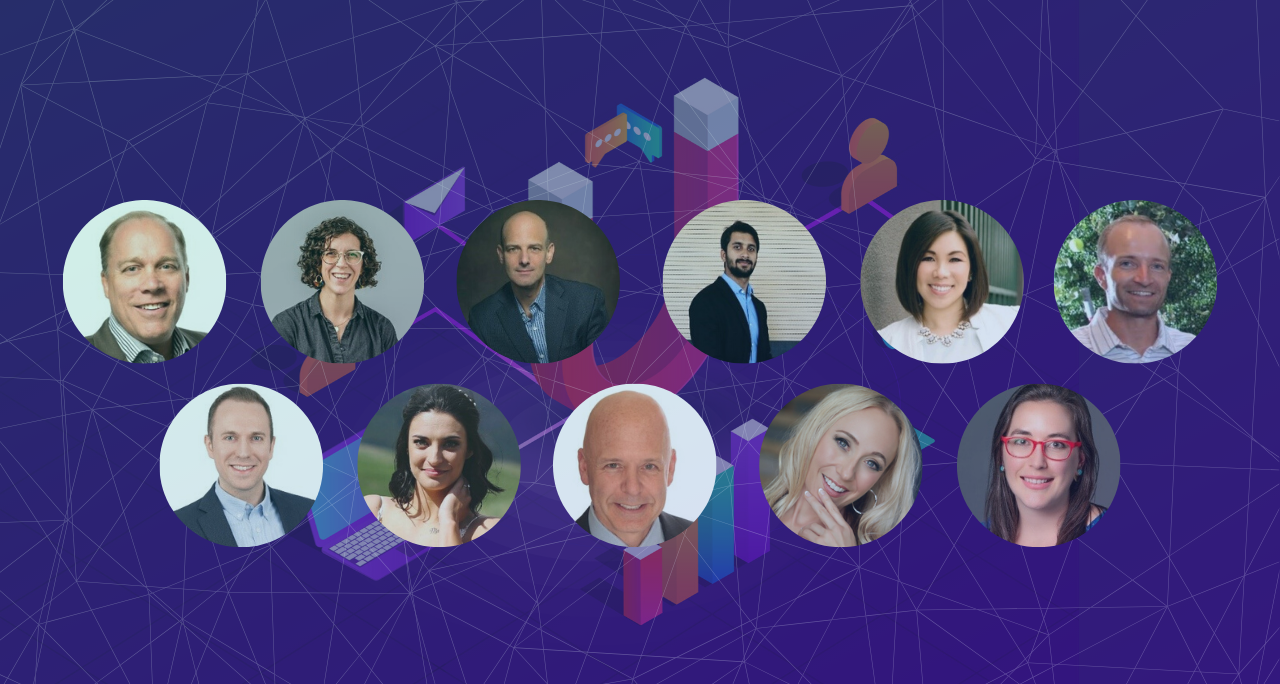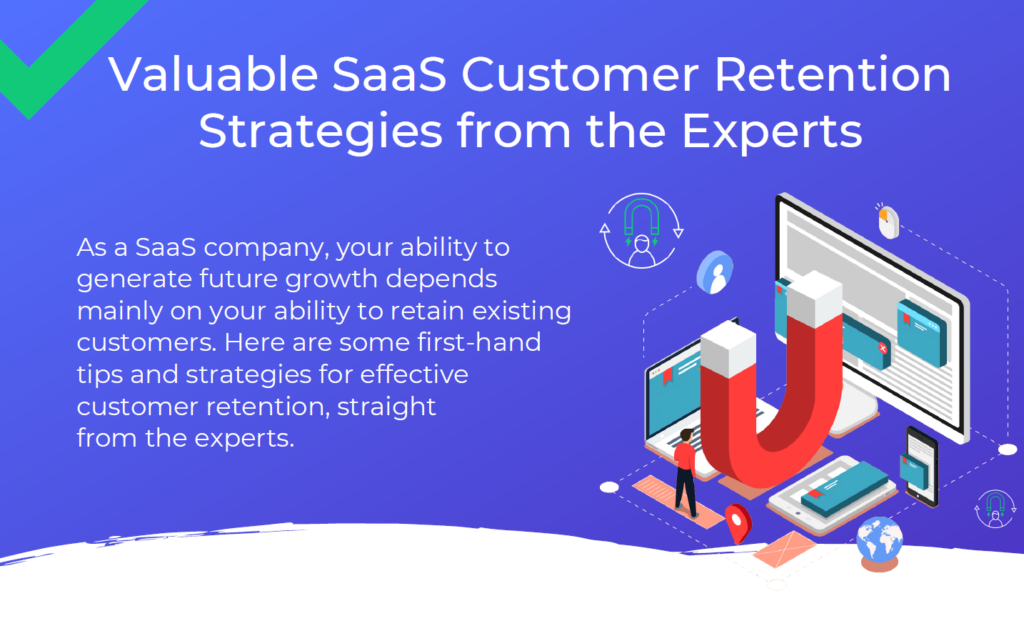Two of the most important pillars for SaaS growth are customer acquisition and customer retention.
During the early days of a business, the goal will be to gain traction. Naturally, customer acquisition will be top of mind in achieving this. However, as a business systematically reaches certain thresholds, growth rates will slow down. Naturally, high-rate growth cannot be maintained on the long run, and certainly not without tremendous costs.
Once you reach that point, your hard work for acquisition has to be complemented by retention efforts. In fact, these efforts are essential for driving the customers further in the SaaS customer lifecycle and making all the acquisition efforts pay off.

As a SaaS company, your ability to generate future growth depends mainly on your ability to retain existing customers in the long run. It is already common knowledge that existing customers have a more significant impact on a company’s bottom line than new customers. Existing customers require lower costs to be maintained and, in light of the trust built with them, they will also spend more on their purchases.
As you can see, customer retention is key to fueling SaaS growth.
Within this stage, some of the metrics you should keep track of include:
- Retention Rate
- Renewal Rate
- Churn Rate
- Net Promoter Score
- Customer Lifetime Value (CLV, CLTV or LTV)
Bonus: Here’s a complete guide to the SaaS metrics that matter – what they are, what they mean, and how to find out if you’re doing well with yours.
In order to maintain a healthy business, you want to avoid the unlucky combination of high acquisition rates along with high churn rates.
The best ways to minimize churn rates and convince your customers to stick with you?
We’ve asked our favorite SaaS experts to share their first-hand tips and strategies for effective customer retention:

Daniel Steinman
Chief Evangelist at Gainsight
“There are three foundational elements of a retention strategy:
- Segment your customers
- Map out your intended journey for each segment
- Build a health score for all customers as your guide
You need to segment your customers because you can’t afford to treat them all the same. High value customers get higher touch for obvious reasons. I recommend three segments and they are usually labeled by the touch model – High-Touch, Mid-Touch, and Tech-Touch. From high to low, the cost of your touch model per customer needs to go down dramatically in order for your Customer Success motions to be financially viable. Segmentation is most commonly done with two variables –
1) How much money is the customer paying you, and
2) How much money COULD the customer be paying you (opportunity).
The first variable is easy, the second one is harder but that’s how most companies do it.
Once you have your segments, you can map out the journey that you want to take those customers on. For High-Touch customers, your journey will involve lots more one-to-one touches and possibly face-to-face meetings. You may have exec sponsorship for these customers as well, with them reaching out quarterly. You’ll probably want to do EBRs every 90 days. It is what the segment name implies – high touch. And expensive. You will need to gear your model based on the value of these customers. That’s why the second variable is key. Even if IBM is paying you a small amount of money, it’s highly likely that there’s a large expansion opportunity there. This would justify having them in your top segment. Everyone just needs to understand that the investment is partially a sales investment, not just a retention investment. Once you map out your journey for the top segment, you can apply the same touchpoints to your lower segment, but you have to reduce the costs.
The levers for doing that are frequency and channel. Less frequent = less expensive. If you do weekly meetings with your top customers, perhaps your Mid-Touch customers get monthly meetings. And their EBRs are twice a year. Or not at all. Totally up to you but the model needs to reflect a lower overall cost. By channels, I mean things like email, webinars, in-app messaging, etc. Applying technology instead of people – over time, this always becomes less expensive. For the Tech-Touch segment, as the name implies, you may have a journey that involves ONLY technology. No live touches at all.
And then you can create a health score. A health score is simply a leading indicator so you don’t have to wait 12 months to measure retention, you can use health score as your proxy. Very similar to how a sales team uses pipeline. If the pipeline is growing and moving, the outcomes are more likely to be achieved. In Customer Success, if the health score trend is upwards, the outcomes are more likely to be achieved. Once you determine the components of your health score, you can start to use the trends of that data to trigger action. This is the key to effective Customer Success – actionable insights. For example, if I know that your usage of my product has dropped off by 25% in the past two months, I will probably want to reach out to you to mitigate the risk. A solid health score is the key to making Customer Success action-oriented which is the key to achieving your retention goals.
If you do these three things and do them well, I guarantee you that you’ll improve your retention numbers. Start today!”

Val Geisler
Chief Email Optimizer at Fix My Churn
“Transactional emails are often written off as nothing more than a receipt. They’re even typically in a completely separate system from traditional marketing emails.
I want you to think about transactional emails as part of your retention strategy: you’re taking time out of your customer’s day asking them to open and read / act on / reply to / file those transactional emails so why not make that time they’re spending with you more awesome? (Here’s a complete guide to doing just that.)
When we provide delight in the little moments, we open up opportunities for connection and a deepening of trust between brands and customers.”

Robert Skrob
President at Membership Services Inc.
“In a world where business experts are telling companies to slash expenses while personal financial gurus are telling consumers to ‘weed out unnecessary subscriptions’ it will become more challenging to grow subscriptions than any time in the last 10 years.
Understanding your ‘Membership Math’ numbers is now more important than ever. While some subscription companies have their CPA, MLV and retention rates, few use them in their cash flow forecasts. Instead, cash flow forecasting is done by the accountants using projections based on previous month’s revenue. Using your KPIs will be critical in measuring your runway. And, how the length of that runway changes as your CPA, MLV and retention rates change.
No MBA program in the world teaches Membership Math. The subscription business is so new, few people recognize the drastic impact that seemingly small changes in CPA, MLV and retention rates impact future cash flows. Membership businesses give you great leverage. But, as those numbers change the leverage works against you.
Subscription businesses will thrive based on how they use their KPI’s to project cash flow as that exercise makes it clear where the biggest opportunities lie within the business.”

Aazar Ali Shad
Head of Growth at UserPilot
“In order to increase retention, I’ve always focused on two things. One, providing more value and education up-front when the new users come in. Second, providing sticky features so that the users think more than twice to churn.
More detail on providing value and education: most of the new users leave your app initially and never come back because they don’t understand how your application works. I learned that with UserPilot too, because of that we focused on amazon onboarding UX, and over-educating the users with free first week one-to-many free webinars, in-app help widget (to teach them how to), great behavior-driven email onboarding, and providing the user best in-app chat support.
Second, users leave your app and churn because they do not feel continuous value in your application. We found that our users are only using us for one or two use-cases. To help users reduce churn, and retain longer, we introduced sticky features. Something that they will continuously find value and cherish and use more than one or two use-cases. In our case, those were in-app native tooltips.”

Ellie Wu
Senior Director of Customer Experience Transformation at SAP Concur
“Design your customer journey as an advocacy flywheel.
When it comes to customer retention strategies, the element that most teams and companies miss is the power of inertia and momentum. While we connect customer data (i.e., value, NPS, CSAT, etc.) to motivate customers to renew, studies have shown that motivation is a feeling and psychological momentum leads to action. Ask any of your sales counterparts – the confidence they have in a deal is based heavily on the engagement inertia with the stakeholders. And, like Newton says, “An object at rest stays at rest, and an object in motion stays in motion.”
Many of the triggers are aimed at reducing churn where the save motion (aka heroics) requires a significant effort to move a customer in a new direction – such as offering discounts to get another chance to prove their worth. Like any relationship, there are plenty of reasons why customers leave, and I’ve seen teams go down rabbit holes chasing these ‘what ifs.’ It is often best to let poor-fit customers go.
Revenue always has a seat at the table, and reducing churn is usually seen as a cost center, so while you are designing retention strategies, keep an eye out for revenue opportunities. Why do our best customers stay? Hone your understanding of your ideal customers and the problems they trust our companies to fix in order to make money, save money, and/or reduce risk. Once we get a clearer picture of this, look at your internal customers along with your external customers. Poor customer experiences are frequently a symptom of organizational duct tape. Where are the lifecycle speedbumps, and how do you shift these opportunities into inflection points that boost the momentum towards that next renewal or expansion? “

Ken Johnson
Co-founder/CXO at Churn Buster
“Lots of SaaS companies are great with product, not-so-great with people. With regard to customer billing issues, they often look at complex solutions before addressing the fundamentals of customer experience.
Here’s a quick win for SaaS companies looking to reduce payments-related churn: wait two or three days before you notify customers of billing issues. Sounds crazy, but simply retrying the card-on-file can clear well over 10% of missed payments. Sending an email at the wrong time will invite support issues, and even a re-assessment of your service—especially if you email someone less familiar with the value you provide. With rare exceptions, SaaS companies should wait before sending that first email.”

Jeff Snyder
President at Elumynt
“The customer experience should feel personal in every way. Ask for feedback constantly and show how you’re putting their feedback into action. Your customers should feel like you’re tailoring your product or service to their needs. And at the very least, make sure your customers feel listened to. For example, a SaaS company may have a backlog of dozens (or hundreds) of feature requests. A quick note every couple of months providing an update on specific requests will go a long way. And when one of those requests is fulfilled, simply let those who requested it know their new feature is available. An automated message from a third-party tool – or expecting customers to read your release notes – is not an exceptional experience; while a (seemingly) personalized message is.”

Kristen LaFrance
Former Head of Growth and Community at Churn Buster
“Improving customer retention is vital to growing and scaling over time but dealing with churn is pretty overwhelming for a lot of SaaS businesses.
Obviously, you need to offer a dependable, valuable tool from the start. But that alone doesn’t really cut it – not in 2020. You need to have processes in place to build a customer experience that stays a step ahead of potential issues.
From the very first touchpoint, through the lifetime of a user’s subscription, you need to create a holistic experience that gets ahead of ‘dangerous’ moments. It’s about predicting and proactively responding to points of friction.
Map out your customer’s journey and focus on the moments where customers actively or passively make decisions that could change their relationship with your tool. From here, you can create systems to counteract potential churn by removing the cross-roads and limiting the churn risk at each moment.
This infographic on churn prevention highlights the most common ‘at-risk churn moments’ we see across the board for SaaS companies.”

Shep Hyken
Customer Service & Experience Expert, NY Times Bestselling Author
“For any subscription model, renewal begins the day the customer starts their subscription. A strong onboarding process is important. Depending on the type of product, this may be done by a ‘customer success’ specialist or through a digital solution, such as video tutorials. Throughout the life of the customer’s relationship there should be touchpoints along the way. These should be more than just announcements of new versions or improvements. Again, a digital solution can handle this, but it must be something that shows interest in the success of the customer, not just an announcement. One final comment: Don’t confuse repeat business with loyalty. Repeat business without loyalty means you are at risk of losing the customer to similar solutions over competitive issues, such as price. When a customer feels a connection to the product and service they have – based on the way they are treated and valued – it’s a competitive advantage.”

Annette Franz
Founder and CEO at CX Journey Inc., Author and Keynote Speaker
“The most important thing any business can do to retain customers is to spend time understanding customers. Customer understanding is achieved in three ways: listening (feedback, data), characterizing (personas), and empathizing (journey maps). When you take the time to understand who your customers are, you learn who they truly are; what their pain points, problems to solve, and jobs to be done are; and how well you are helping them to achieve all of that. If you’re not bringing the customer voice into all you do, you don’t design an experience for them and cannot help them solve their problems; ultimately, you are not delivering value for them. When you help them and deliver value, you have a foundation for customer retention and loyalty.”

Bri Adams
Customer Success Team Lead at ChurnZero
“You’ll learn more from your customers than you ever thought possible in two key ways:
- First—in terms of collaboration. SaaS (and Customer Success) are two industries where people are eager to share what they have learned and are excited to learn from you as well. If you are experiencing an internal problem, I encourage you to ask your customers if they have experienced something similar. If they have, I bet they’ll be willing to share their learnings. If they haven’t, they’ll still respect you for being candid—and honesty and respect go a long way.
- Second—in terms of data. With so much customer data at our fingertips—from a customers’ product usage, email and support ticket metrics, and purchase history to NPS and CSAT scores, onboarding Journey data, and automated Playbook engagement—we can identify ways to optimize their experience, remove friction, and meet their future needs without the customer ever having to say a word.
Be Flexible. Every business today is experiencing challenges they didn’t foresee. If there is anything you can do to be flexible—whether it’s holding their hand a little bit more when you previously asked them to complete a task on their own, or allowing them to delay their next invoice by 30 days—do it. They’ll remember those thoughtful gestures and the vendors that genuinely showed up for them during their time of struggle.
Retention Strategy. When all is lost, the easier you make it for someone to end their subscription with you, the more likely they are to come back or stay. Don’t make your customer jump through hoops to part ways—they will hold it against you.
It’s also important to remember that in times of crisis, people find it difficult to be proactive and are worse at making decisions. Don’t forget the crucial ways you can help your customers. If their cancelation reason is software related, you could offer a free add-on, dedicate more time to help them configure their platform, or provide best practice advice on a topic that has nothing to do with your product. Better yet, do them all.”
These were some killer insights, right?
Here are some takeaways:
- Take the time to understand your customers inside and out (collect and leverage customer data, ask for feedback, segment your market, and build dedicated customer journeys for each segment)
- Use the findings to optimize and personalize their experience
- Remember that repeat purchases do not necessarily mean loyalty, and your retention efforts start from the very first day the customer activates the subscription. That’s why effective retention depends on top-notch onboarding and in-app experience.
- Consider tactics like transactional emails and involuntary churn reduction to retain more customers.
Hope you found valuable learnings in these expert insights. We sure did!
Let us know in the comment section below what retention strategies you are considering for your business.
For a visual overview of the takeaways, check out this dedicated infographic!






